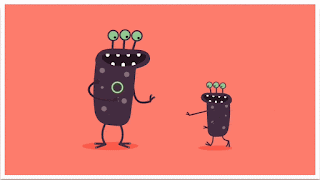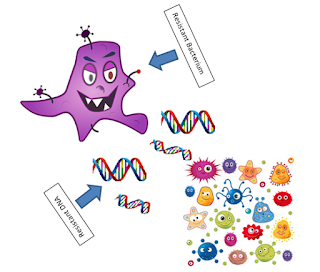First of all we must know
certain basic definitions to differentiate most interchangeably used terms like chemotherapy, antibiotic, and
antibacterial/antimicrobial agent.
Chemotherapy
‘It is treatment of infections with specific drugs that selectively suppress the
infecting microorganism without significantly
affecting the patient.’
For example:
If the patient is suffering from throat infection
(due to gram positive bacteria), patient is treated with medication which will
harm/kill the bacteria present in throat, but will produce less or no harm to the patient.
The same thing occurs in therapy
of cancer, where medications are given to
patient which harm/stop
growth of “Tumer Cells”, with less or no harm to
patient.
Hence the cancer therapy is
known as chemotherapy.
Note that treating any
infection with antimicrobial drug can be considered as chemotherapy.
Antibiotics
These are substances
produced by microorganisms, which
selectively suppress the growth of or kill other microorganisms at very
low concentrations.
For
example, throat infection due to gram positive bacteria can be treated with
penicillin (a substance produced by another group of bacteria, Penicillin
Notatum)
Both antibiotics and
chemotherapeutic agents are commonly known as AntiMicrobial Agents (AMA).
It refers to unresponsiveness
of a microorganism to an Antimicrobial agents,
and is similar to the phenomenon of tolerance seen in human.
There are two types of resistance.
1. Natural,
2. Aquired
There are two types of resistance.
1. Natural,
2. Aquired
Some microbes have always been
resistant to certain antimicrobial agents which is known as Natural resistance.
They lack the metabolic process or the target site which is affected by the particular drug.
They lack the metabolic process or the target site which is affected by the particular drug.
This is generally a group or species characteristic,
E.g. Gram-negative bacilli (a type of bacteria causing food poisoning, gastroenteritis, urinary tract infection and many more) are normally unaffected by penicillin G.
This type
of resistance does not pose a significant clinical problem.
Some microbes develop the resistance (which was sensitive before)due to the use of an AMA over a period of time known as Acquired resistance.


This can happen with any microbe and is a major
clinical problem.
However, development of resistance is dependent on the microorganism as well as the drug.
Some bacteria are notorious
as they rapid acquit resistance
e.g. tubercle bacilli (The
reason for long term therapy of Tuberculosis).
Others like spirochetes
(Present in teeth) have not developed significant resistance to penicillin
despite its widespread use for > 50
years.
years.
Resistance may be developed
by mutation or gene transfer.
Mutation
It is a stable and heritable genetic change
that occurs spontaneously and randomly among microorganisms.
It is not induced by the AMA.
Any sensitive population of
a microbe contains a few genetically modified cells which require higher concentration
of the AMA for inhibition.
These are selectively
preserved and get a chance to proliferate when the sensitive cells are
eliminated by the AMA.
Thus, in time it would
appear that a sensitive strain has been replaced by a resistant one.
E.g. When a single
antitubercular drug is used.
As Tubercular bacterium easily acquires resistance, hence multi drug therapy for long period (3-8 months) are given.
If single drug treatment would be done it would easily develop resistance against that drug.
As Tubercular bacterium easily acquires resistance, hence multi drug therapy for long period (3-8 months) are given.
If single drug treatment would be done it would easily develop resistance against that drug.
Elaboration of mechanism of Mutation
Suppose a patient has
infection of gram positive bacteria. He is prescribed Penicillin G for 5 days,
daily once.
For
first three days patient takes it regularly which destroys 80% of bacteria, now
patient has stopped taking the drug.
The
drug concentration will become low in body and remaining 20% bacteria will get
chance to survive.
Now these 20% bacteria has
altered their genes and are resisted to penicillin G.
These
20 % bacteria will grow, are now they are more power full with altered gene structure,
requiring new way to be killed.
Mutation may be:
(i) Single step: A single gene mutation may confer high degree of
resistance; emerges rapidly,
(ii) Multistep: A number of gene modifications are involved; sensitivity
decreases gradually in a stepwise manner.
Resistance to erythromycin (Drug used against gram positive bacteria, for throat infection)
Sometimes mutational changes in bacteria may decrease their severity to produce damage.
Gene transfer (infectious resistance) from one organism to another can occur by:
(i) Conjugation
Sexual contact through the
formation of a bridge or sex pilus is common among gram-negative bacilli of the
same or another species.
This may involve chromosomal
or extrachromosomal (plasmid) DNA.
The gene carrying the ‘resistance’ or ‘R’ factor is transferred only if another ‘resistance transfer factor’ (RTF) is also present.

The gene carrying the ‘resistance’ or ‘R’ factor is transferred only if another ‘resistance transfer factor’ (RTF) is also present.

Conjugation frequently
occurs in the colon where a large variety of gram-negative bacilli come in
close contact.
Even nonpathogenic
organisms may transfer R factor to pathogenic organisms, which may become
widespread by contamination of food or water.
Chloramphenicol resistance
of typhoid bacilli.
(ii) Transduction
The R factor is taken up by
the phage and delivered to another bacterium which it infects.
Many Staph. aureus strains
have acquired resistance by transduction.
(iii) Transformation
A resistant bacterium may
release the resistance carrying DNA into the medium and this may be imbibed by
another sensitive organism—becoming unresponsive to the drug.
Resistance once acquired by
any of the above mechanisms becomes prevalent due to the selection pressure of
a widely used AMA,
i.e. presence of the AMA
provides opportunity for the resistant subpopulation to thrive in preference to
the sensitive population.
Resistant organisms can
broadly be of the following three types:
(a) Drug tolerant
Loss of affinity of the
target biomolecule of the microorganism for a particular
e.g. resistant Staph. aureus and E. coli develop a RNA polymerase that does not bind rifampin,
e.g. resistant Staph. aureus and E. coli develop a RNA polymerase that does not bind rifampin,
Another mechanism is
acquisition of an alternative metabolic pathway,
e.g. certain sulfonamide resistant bacteria switch over to utilizing preformed folic acid in place of synthesizing it from PABA taken up from the medium.
e.g. certain sulfonamide resistant bacteria switch over to utilizing preformed folic acid in place of synthesizing it from PABA taken up from the medium.
(b) Drug destroying
The resistant microbe
elaborates an enzyme which inactivates the drug,
e.g. β-lactamases are
produced by staphylococci, Haemophilus, gonococci, etc. which inactivate penicillin
G.
(c) Drug impermeable
Many hydrophilic
antibiotics gain access into the bacterial cell through specific channels
formed by proteins called ‘porins’, or need specific transport mechanisms.
These may be lost by the
resistant strains, so drug can not enter in to bacterial cell.
Cross resistance
Acquisition of resistance
to one antimicrobial agent (AMA) conferring resistance to another AMA, to which the organism has not
been exposed, is called cross resistance.
This is more commonly seen between chemically or mechanistically related drugs,
e.g. resistance to one sulfonamide means resistance to all other drugs of this class.
Such cross resistance is often complete. However, resistance to one aminoglycoside may not extend to another, e.g. gentamicin-resistant strains may respond to amikacin.
Sometimes unrelated drugs show partial cross resistance, e.g. between tetracyclines and chloramphenicol, between erythromycin and lincomycin.
This is more commonly seen between chemically or mechanistically related drugs,
e.g. resistance to one sulfonamide means resistance to all other drugs of this class.
Such cross resistance is often complete. However, resistance to one aminoglycoside may not extend to another, e.g. gentamicin-resistant strains may respond to amikacin.
Sometimes unrelated drugs show partial cross resistance, e.g. between tetracyclines and chloramphenicol, between erythromycin and lincomycin.
Cross resistance may be
two-way, E.g. between erythromycin and clindamycin and vice versa,
or
one-way, E.g. development of neomycin resistance by entero-bacteriaceae makes them insensitive to streptomycin but many streptomycin-resistant organisms remain susceptible to neomycin.











Something different you need to acknowledge when finding the best rehab center is that you in like manner need to consider the charges and your money related arrangement. Recollect that there are charges that ought to be paid when the alcohol rehab treatment. Regardless, if you have to find the best decision, you can by and large glance through on the web. There are alcohol rehab foundations that offer their organizations on the web.
ReplyDeleteinspirational quotes about recovery from addiction
inspirational recovery quotes for addiction
Concerning prescriptions or alcohol, choice is only a factor in irrefutably the beginning stage, when customers appreciate just with some limitation. Here, they are responsible for their utilization, anyway oppression is something that can without a very remarkable stretch come up, driving people to then get dependent, subordinate, and obliged. To a great extent it might be explained as a basically physical, and programmed, response/reaction to the refreshment. Without a doubt choice can come into it, anyway then correspondingly things can twisting wild moreover.
ReplyDeleteoutpatient alcohol rehab florida